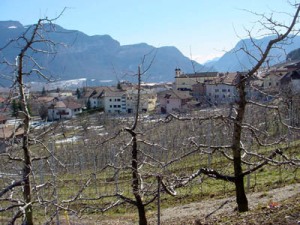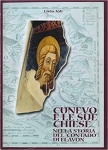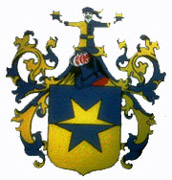
Panorama of Cunevo
Cunevo is a small village of less than 600 residents in Val di Non (Non Valley) about 16 miles (25 km) north of the city of Trento. In 2016, it, along with the nearby villages of Flavon and Terres, was aggregated into the Comune of Conta’.
Origins: One theory is that the Cunevo name is derived from a Celtic mythological figure named “Cuaser”, which evolved into the early form “Cuneu”. The village name has been documented to writings of the 13th century: “Cunedo” in 1214 and “Cunevo” in 1251.
Based upon archeological findings, there is evidence that the Gauls, Venetians, and Longobards settled in the Cunevo area. It is thought that the first inhabitants of the area lived in the caves of Cunevo’s Mt. Corno, which afforded protection against man and beast.
One of the most spectacular archeological findings was made in 1890 in the area known as “Plagi” ,on land belonging to Luigi Iob (son of Giuseppe Iob-sicher). Two graves were unearthed containing pieces of skull, vases, cups, and pottery. Archeologists determined that the graves were Roman, dating from the end of the 3rd to the beginning of the 4th centuries.
Early Family Records — Many old parchments have been discovered in the archives of the Spaur family (counts that controlled the Val di Non area). For example, a Micheli (no other info given), originally from Terres, was mentioned as living in Cunevo in a document dated circa 1373. Another dated 1400 mentions Bartholomeo and Federico, brothers living in Cunevo. Prior to the mid-late 1400’s surnames were rarely used by villagers. Thus, early documents mentioning residents of Cunevo were simply Bonaventura (year 1269), Aloisus, son of Amidanti of Cunevo (year 1298). Zanon (Zanin) — an early form of this name (de Zanonis) has been found in written records of Cunevo dating to at least the year 1541. Dalpiaz (origination likely from the nearby village of Terres, and present in Cunevo since at least 1691).
In his book “Cunevo e le sue Chiese”, Livio Job has provided an extensive history of Cunevo and its people. Using documents and records from private and public archives, he developed a genealogy of one of the noble Job branches to the early 1400s. Without access to such records and enormous availability of time, you and I  cannot trace families of Cunevo much before 1802. The birth, marriage, and death records for Cunevo were maintained at the church in nearby Flavon, along with the records of Flavon itself and the village of Terres. Unfortunately, in August 1802 a fire broke out in Terres, and spread to Flavon. That fire devastated the two villages, destroying the major parts of each, including the records maintained by the church. Those records have not been reconstructed.
cannot trace families of Cunevo much before 1802. The birth, marriage, and death records for Cunevo were maintained at the church in nearby Flavon, along with the records of Flavon itself and the village of Terres. Unfortunately, in August 1802 a fire broke out in Terres, and spread to Flavon. That fire devastated the two villages, destroying the major parts of each, including the records maintained by the church. Those records have not been reconstructed.
 House in Cunevo (old and new portions)
House in Cunevo (old and new portions)
Houses — During the early 1800’s and prior, houses in Cunevo, as was the custom in many other villages in Val di Non, were given numbers rather than street addresses (street addresses are a more recent development). If you are researching your family, you will see that the church registers (the village church was generally the recordkeeper in Trentino) state a person lived at house #7 or house #23, etc. I am not sure how the numbering was determined. Very often, two or three generations of a family lived in the same house.Many of the residential homes in Cunevo have portions that are more than 200 years old. Some of the features were retained during remodelling and expansion. In the photo above, note the newer construction on the left, and a home on the right that is apparently quite old. There are a few interesting items at the older home (what appears to be a handmade broom, stone construction, wooden beams, and a white-painted square that could have borne the original house number.
Surnames — IOB (also spelled JOB) is the most common surname in Cunevo. Distinctions between various branches of the families bearing the IOB name are made through the use of “second” names (“sopranomi“) such as Iob-sicher, Iob-remus (in use since at least 1783), Iob-perotel, Iob-bottes, Iob-brun, Iob-bertol (in use since at least 1691). Family nicknames are also used (mavador, smit, pastor). Due to intermarriage between the branches, it is very common for a villager to be descended from 2, 3, or 4 branches of IOB’s. The village church marriage records for the 1800s have many instances where religious dispensations were granted allowing the marriage of 2nd, 3rd, and 4th cousins.
Related Posts:








